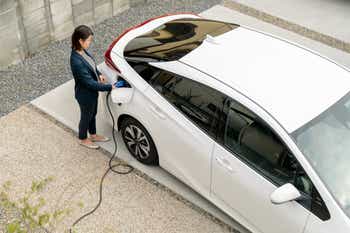Electric vehicles (EVs) are more popular than ever, and it’s easy to see why. They’re efficient, eco-friendly, and offer a great driving experience. But one of the biggest perks of owning an EV is the ability to charge it at home. Whether you have a garage or not, there are plenty of ways to charge your EV at home. This guide will walk you through all your options, from simple setups to solutions tailored for people without a garage.
Can You Charge an Electric Car at Home?
Yes, you can charge an electric car at home, and it’s one of the most convenient, cost-effective ways to power your EV. With the growing popularity of electric vehicles, manufacturers and utility companies have made home charging solutions more accessible than ever. Whether you have a garage, a driveway, or even limited outdoor space, there are several options to suit your needs.
In fact, charging your EV at home offers several advantages over using public charging stations:
- Convenience: Home charging eliminates the need to make special trips to public stations. You can charge overnight and wake up to a full battery, saving time and effort.
- Cost savings: Home electricity is usually cheaper than public chargers. Plus, charging during off-peak hours can save you even more on your electric bill.
- Control: With a home charger, you’re in control. You can decide when and how to charge, and if you’ve got solar panels, you can even power your car with clean, renewable energy.
- Peace of mind: With a dedicated home charger, you avoid the unpredictability of public chargers, such as long wait times or unavailable stations.
Understanding EV Charging Levels
Let’s break down the three main levels of EV charging and how they fit into your lifestyle.
Level 1 Charging (Standard Outlet)
Most electric vehicles come with a Level 1 charger, allowing you to plug your EV directly into a standard household 120-volt outlet. While Level 1 charging is easy and convenient, it’s not fast. Typically, your EV will receive 3-5 miles of range per hour of charging, meaning you’ll get up to 60 miles of range in a 12-hour period. Level 1 charging is better suited for shorter daily commutes where you’ll be driving less than 40 miles per day.
Level 2 Charging (Faster Home Charging Option)
For a faster, more efficient option, Level 2 charging is the go-to choice for most EV owners. Level 2 chargers can add up to 40 miles of range per hour, making it a great option for those who drive regularly or want a quicker turnaround for charging.
However, you’ll need to install an electric car home charger, which might involve hiring an electrician to set up the 240-volt outlet. If you don’t have a garage, weatherproof outdoor chargers are available for driveways or outdoor spaces.
Level 3 Charging (DC Fast Charging – Not for Home Use)
Level 3 charging, also known as DC fast charging, is the quickest way to charge an EV. They can add 100-200 miles of range in as little as 30 minutes, depending on your EV’s charging capacity. However, they’re not designed for home use. They’re ideal for road trips or when you need to recharge quickly on the go, considering you can only find these types of chargers at public charging stations.
How to Charge an Electric Car at Home Without a Garage
Not everyone has the luxury of a garage, but that doesn’t mean you can’t charge your electric car at home. Whether you live in an apartment, a home without a garage, or rely on outdoor parking, there are plenty of solutions to keep your EV powered up.
Outdoor Charging Solutions
If you park in a driveway or another outdoor space, a weatherproof EV charger is one of the best options for charging your car at home. Many Level 2 chargers are designed to withstand the elements, with durable enclosures that protect against rain, snow, and extreme temperatures.
Here are some key considerations for outdoor charging setups:
- Weatherproof chargers: Look for chargers with ratings such as NEMA 3 and NEMA 4, which are specifically designed for outdoor use. These chargers can handle exposure to moisture, dirt, and dust.
- Safety first: Proper cable management is essential to prevent tripping hazards and to protect the charging cable from damage. Using protective conduits or mounting the cable on a wall can help keep it secure.
- Charging in any weather: Modern EV chargers are built to function in a variety of weather conditions, but always follow the manufacturer’s guidelines. For example, avoid charging during severe storms or floods for safety reasons.
Shared or Community Charging Options
If you live in an apartment or don’t have access to a dedicated parking spot, many apartment complexes are starting to add EV chargers in shared parking areas. If yours doesn’t have one yet, talk to your landlord or property manager. There are often rebates or incentives that make installation easier and cheaper for them.
Also, some neighborhoods and residential developments are partnering with charging companies or local governments to install chargers for shared use. These chargers are typically placed in parking lots or other central locations and make it easy to plug in. Apps like PlugShare can help you locate shared chargers nearby.
How to Install an EV Charger at Home
Whether you’re planning to set up a charger in your garage, driveway, or outdoor parking space, here are some steps you should take:
- Evaluate your home’s electrical system: Determine if your home’s electrical panel can handle the additional load of an EV charger. Most Level 2 chargers require a 240-volt outlet, which might mean upgrading your system if it’s older or near capacity. A licensed electrician can assess your panel and recommend any necessary upgrades.
- Choose the right charger: Many brands sell Level 2 chargers. Some even have smart features, like Wi-Fi connectivity, which lets you monitor charging remotely. If you don’t have a garage, choose a weatherproof charger designed to withstand the elements, such as rain, snow, and extreme temperatures.
- Get any necessary permits: Check with your local government to see if permits are required for installing a 240-volt outlet or making changes to your electrical system. Many electricians will handle the permitting process for you, so ask if it’s included in their services.
- Hire a professional electrician: Installing an EV charger involves high-voltage electrical work, so it’s not a DIY project. A certified electrician will ensure the installation is safe and up to code, handle any necessary panel upgrades or wiring, and test the system to make sure everything works properly.
How much does it cost to install an EV charger at home? The installation cost can range from $500 to $2,000, depending on your home’s electrical system and the type of charger you choose. Many states and utility companies offer rebates or incentives for EV charger installations, so check for programs in your area to help reduce costs.
Cost of Charging an EV at Home
One of the perks of owning an electric vehicle is that charging it at home is usually more cost-effective than relying on public charging stations, which can set rates at $0.20-$0.60 per kWh or more. However, the actual cost of home charging can vary depending on a few key factors:
- Electricity in your area: Electricity prices vary depending on where you live. In some states, power is relatively cheap, while in others, it’s a bit more expensive. Many utility companies also offer time-of-use plans, so you can save by charging your car during off-peak hours, like late at night.
- Battery size: The bigger your car’s battery, the more it’ll cost to fully charge. For example, a compact EV with a 40 kWh battery will cost less to charge than an SUV with a 100 kWh battery.
- How often you charge: If you’re driving less, you’ll need to charge less often, which naturally keeps your costs lower. On the other hand, if you’re commuting a lot or taking frequent trips, you’ll be plugging in more often.
Owning an EV can also help you save on EV auto insurance. Many providers offer discounts specifically for electric vehicle owners, so reach out to your provider to see what auto insurance discounts you might be eligible for.
Conclusion
Charging your electric car at home, whether you have a garage or not, is easier than ever. From weatherproof outdoor chargers to shared community solutions, there are plenty of options to fit your lifestyle.
Want to learn more about electric vehicles? Mercury Insurance provides several EV resources to help you make the most of owning an electric car, from tips on maintaining your EV to understanding its insurance needs.


